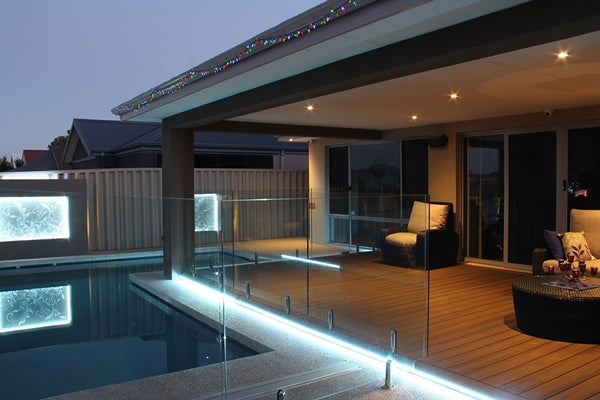This article is a continuation to our previous article, The Landscaper's Guide to Landscape Lighting Design - Part 1. If you have not read it, you can check it out here.
In the previous part of the article series, we have covered some important parts of planning and designing a landscape lighting system such as:
- The design objective
- Common lighting fixtures used in a landscape lighting system
- Common landscape lighting techniques
- The design process
Thus, in the second and final part of the article series, we will move on to the execution of the design, covering calculations, installations, and other technical aspects required.
Before we begin, you might also want to check another one of our article covering voltage selection for a landscape lighting system here.
As mentioned in those articles, proper calculations of transformer and wire sizing are highly essential in a low-voltage landscape lighting system, so it will be the first topic of our discussion.
Transformer Sizing
Before we begin, transformer sizing will only be a necessary step in a low voltage system. If you are planning to use 120/240-v line voltage for your landscape system, you may skip this part. The same case will also apply if your household runs on a full DC-voltage source such as a solar panel kit.In part 1, we have discussed a simple two-step approach for transformer sizing, they are:
- Calculate the total sum of the wattage of all lamps.
- Your total sum should be no more than 75% of the transformer's capacity. Meaning if your total sum is 225, you should use the 300W capacity transformer.
Here are some of the more detailed guides and tools for those who might need a more technical and precise approach:
- Transformer power calculation by HyperPhysics
- A detailed transformer sizing guide from Dongan (PDF)
Wire Sizing
Again, if you are using line voltage as your source, you may skip this step, as your wire size will generally be a fixed size.
However, wire sizing will also be an important step if you are using a DC power source for your household.
Reviewing our simple set of rules of wire sizing we mentioned in part 1, they are:
- If the wire run consists of more than 100 watts of load, you will definitely need to use the #10/2
- If the wire run is less than 100 watt in load, use #12/2 if the cable length is less than 100 feet long. Otherwise, also use #10/2
Other wire sizes such as #8/2 can be used, but it is extremely expensive, and it's better to use two #10/2s in place.
A wire run is the length of the wire running from the transformer to a splice. You can also use a wire sizing calculator from Energy Development Co-operative here.
Improper wire sizing in a low-voltage system can lead to voltage dops, loss of efficiency, and even lethal overheat and fire accidents.
Underground Cable Installations
For any outdoor electrical wire installations, you can either run your cables overhead, or buried underground. However, some countries' national electrical codes will require an underground installation.
Even when it's not a legal necessity, running your cable underground will be beneficial in both aesthetic and safety. The safety concern will be a more pressing issue if you use line voltage, since water damages from rain or other damages may cause lethal electrocution.
Several methods (and depths) are available. In general, the deeper the burial will be, the cheaper the investments required for the wires and conduits. However, digging deeper may also cause higher investments and labor costs for the digging process, as well as disrupting other underground systems previously installed (irrigation, existing wires, etc.)
Using a line voltage system will also need conduits, while it will not be necessary in a low-voltage system. The minimum burial requirement for a low-voltage system is 6", and is generally an easier process compared to the line voltage system.
For a line voltage system, here are some considerations:
6" depth
You can use the 6" depth for a line-voltage system. However, you will need 1/2" galvanized metal rigid electrical conduits. You will also waterproof wires, so look for those with THWN or similar labels.
1/2" conduits as well as waterproof wire might be costly, but this method should be considered when deeper digging is not possible, or if you will only need a short cable run.
12"-18" depth
12" is the most preferred depth because of the balance of digging difficulty and required investments. Generally, you can use UF-B cables combined with approximately 1/2" PVC conduits.
24" depth
At 24" depth you can run direct burial UF-B cables. Although technically the 24" depth is the safest, you will require more digging in the process. You might need the help of a trench digger.
Here are more quides for underground cable burial:
- A guide to installing a 12" deep underground cabling system from Family Handyman.
- A guide to installing PVC conduits, again from Family Handyman.
- A video tutorial by ReefDVMs covering underground cables with PVC conduits.
The type of your soil (soft/hard), existing underground installations, and budget must be considered before you are deciding for burial depth. Based on the complexity of the digging process, the low-voltage system is generally more preferrable because of the easier underground installation and safety.
End Words- Let Us Install Those Fixtures

Once you understand the technicalities required for a landscape lighting installation, it is time to install the fixtures. Refer to the first part of the article series to review many fixture placements and techniques available.
After the fixtures are mounted, make sure to lamp each of them according to type, beam spread, and wattage you planned in the previous step.
Remember, before you begin any installation, make sure to get some information regarding your local electrical regulations. The requlations for low voltage and line voltage may also be different, consult your local authorities if necessary.

